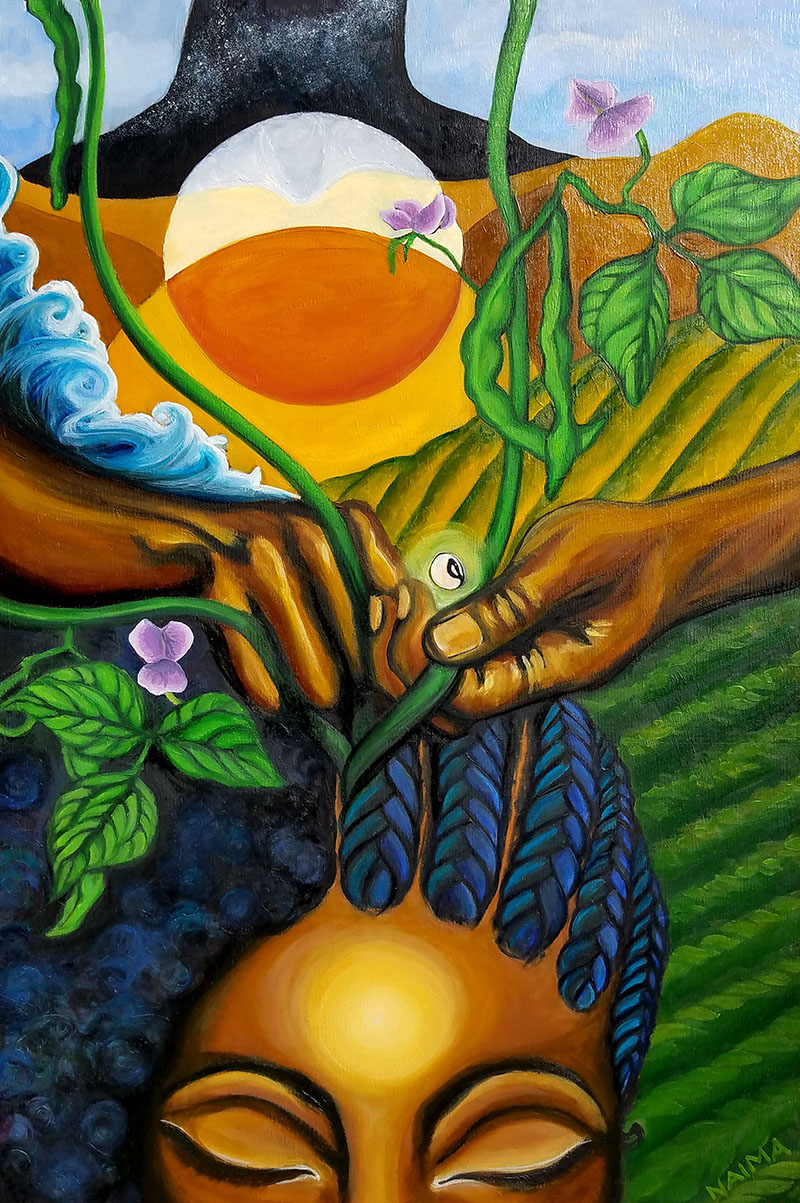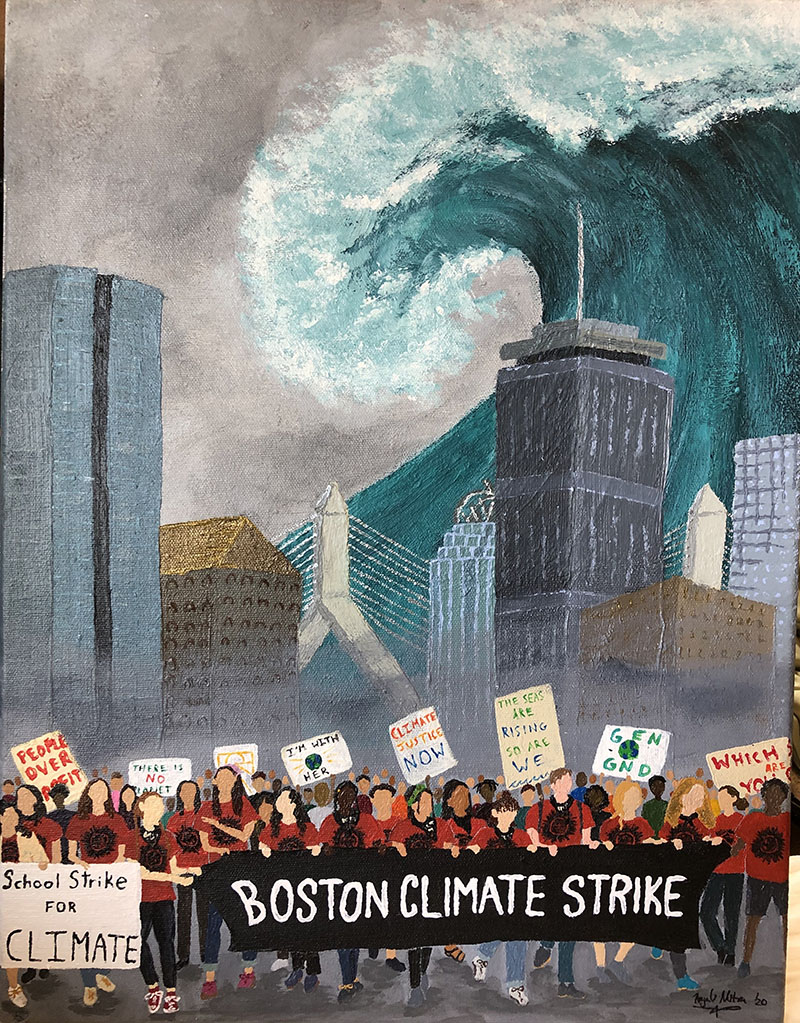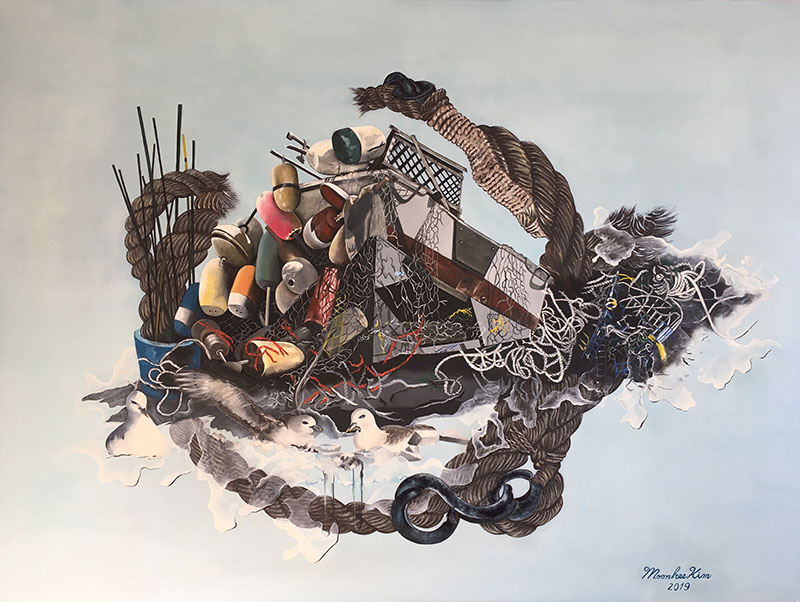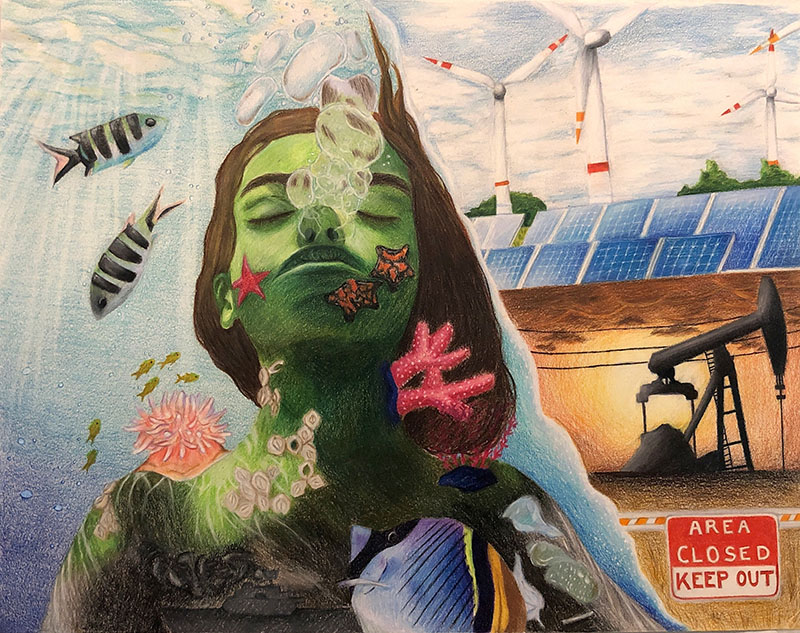Science is objective; art is subjective. Science involves facts and figures, and art employs whimsy and creativity. But the Peabody Essex Museum’s exhibit Climate Action: Inspiring Change proves that science and art are just two sides of the same coin—often helping each other communicate information more effectively together rather than alone.
Science and art are two of humanity’s most impressive hallmarks, and together they help inspire optimism about climate change at the exhibit in the museum’s Art & Nature Center. Curated by Janey Winchell, director of the center and curator of natural history, Climate Action: Inspiring Change assembles the work of nineteen artists and nine youth artists, using media like paintings, drawing, sculptural works, clothing, an installation piece, and interactive art.

The exhibit brings together the perspectives of artists and the science behind climate change to help folks understand “how we got here,” says Winchell, “and where we can take meaningful action to move us toward a future we want to be in.”
Some pieces are data-driven and look like they’re right out of a digestible textbook. An interactive piece explains the connection between the fossil fuel industry and our banks, and data art by Jill Pelto turns graphs into beautiful landscapes, helping viewers better conceptualize what the graph explains.
Other works take a more artsy form. Surrealist paintings envision a subaquatic future, clothing by Emily McNichols becomes powerful wearable art, and David Greendeer, of the Narragansett and Ho-chunk tribes, displays a set of hand drums.
The nine youth artists whose work Winchell pulled for this exhibit were featured in Bow Seat’s Ocean Awareness Contest, an annual international competition in which youth artists are encouraged to submit work relating to the health of our oceans. The youth climate movement and its diligent work, says Winchell, is what inspired her to pursue this exhibit in the first place.

Most of the exhibit’s 28 artists, including multiple youth and Native American artists, are based in New England, a crucial facet of the exhibit’s curation, according to Winchell. “I do think that sometimes people look at this as an issue that’s happening somewhere else,” says Winchell, “and actually there are very real and tangible impacts of climate change already evident in our region.”
Like the exhibit’s title says, the exhibit means to be a catalyst for change, says Winchell, succinctly answering the question, “What climate action is really going to make the biggest difference right now?”
“The exhibits we do in the art and nature center are really intended to be inviting and welcoming to family audiences,” says Winchell, noting that when curating the exhibit she took care to choose pieces that were accessible and engaging, rather than overwhelming. “We have reason to be hopeful and reason to be optimistic, especially if we are acting with urgency and with intention,” says Winchell.

The museum partnered with the Climate Museum in New York, directed by Miranda Massie, on Climate Action: Inspiring Change. “Over the past few years, there’s been a rise in artists communicating about the climate crisis across nations and genres,” says Massie, adding that art can create a sense of community and connection vital for mobilizing collective action about the climate crisis.
That’s the important role art can play in climate action—in an exhibit like the Peabody Essex Museum’s, art meets the viewers where they’re at. While scientific facts provide a solid framework, artwork connects with folks “on an emotional level,” says Winchell.
“It’s exciting to emphasize the importance of how art can communicate important scientific information,” says Lela Clawson-Miller, manager of the museum’s Art & Nature Center, describing the exhibit as a “celebration of art and science together.” Climate change is an emotional issue, and for folks who feel concerned or even hopeless about the crisis, this exhibit provides the powerful message that the solutions are already out there.
The museum will also put on special programming in conjunction with Climate Action: Inspiring Change this April vacation. On April 19 and 20, Jill Pelto hosts data-art workshops and art-making drop-ins; on April 21, David and Danielle Greendeer hold a morning drum-making workshop and afternoon drumming and movement workshop, along with a reading and craft session geared toward younger children; and on April 22, UMass professor Elizabeth Sweet hosts an afternoon body-mapping workshop.
Throughout the week, the museum also partners with leading climate and conservation organization Rare on small pop-up exhibits, each giving viewers bite-sized climate actions we can all easily take.
Digestibility is the key to the museum’s current programming on the climate, a topic we’re often barraged with information about. “That can start to feel kind of numbing, as though there’s just more and more bad news,” says Winchell. The works in Climate Action: Inspiring Change aim to leave viewers feeling empowered, not dejected, and engage with viewers on a personal level. It’s from that place, says Winchell, that folks can then “recognize our own potential for impact,” she says. “We’re not powerless.”

